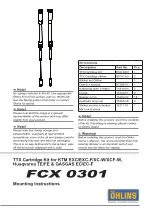
34
004778240 - 15/04/2020
L’immagine è puramente indicativa.
D
H=2D
max 45°
A
5.7 Air intake
The Termopalex unit must receive sufficient
combustive air to ensure correct combustion.
The creation of an external air intake is
mandatory, to ensure the flow of com-
bustive air to the appliance and/or recir-
culation of ambient air.
The air intake must be of the right size
(see Table
5.7)
and protected by an anti-insect grill; it must
also be positioned so that it cannot be acciden-
tally obstructed.
The components of the combustion product
fume evacuation systems must be declared
suitable for the specific operating conditions and
provided with marking
(through the decla-
ration or certificate of conformity or European
technical approval of the product).
It is advisable to install a collection chamber with
an inspection port, for solid materials and any
condensate, under the inlet to the smoke duct
(Fig. 5.6a)
.
Fume stacks in very poor condition built using
unsuitable materials are banned by law and
compromise the correct operation of the stove.
To provide a perfect draft the fume stack must be
free of obstructions such as bottlenecks, horizon-
tal routes and live edges; any deviations out of
axis must follow a slanted route with a maximum
angle of 45° from the vertical axis (preferably
only 30°). These variations should preferably be
implemented near the chimney.
The dimensions of the fume stack must be cal-
culated in accordance with standard EN 13384-1.
Use metal curves and pipes of appropriate
thickness for the smoke duct that connects the
Termopalex unit to the fume stack, taking care
not to exceed an angle of 45° if the fume stack is
not perpendicular to the stove
(Fig. 5.6b)
.
Do not use glass wool or insulation that
has a paper support: these materials
might catch fire.
All components in the fume stack
system must be declared suitable for
the specific operating conditions and
have the CE marking.
The smoke duct
(A - Fig. 5.6b)
between the
stove and the fume stack must have the same
cross-section as the stack's fume outlet. The flue
coupling must be sealed. The use of extending/
flexible metal pipes is forbidden. Changes in
direction from the appliance's fume outlet must
be made with elbows at no more than 45° (pref-
erably only 30°) from the vertical axis.
The chimney must be wind proof with an internal
cross-section equivalent to that of the flue and
a fume outlet section at least twice that of the
internal flue pipe.
Fig. 5.6a
Fig. 5.6b
The image is merely indicative
















































